This is a continuation of my history of the ownership of the Rittenhouse Tavern. The previous article covered the period of time when members of the Rittenhouse family owned the tavern. The following article looks at the subsequent history, starting with James Wolverton and Mary Ann Sergeant in 1843, George Hoppock and Jane Elizabeth Wolverton in 1868 and Lambert B. Mathews and Lizzie Nixon in 1910, and ending with Frank W. Reading and Charlotte Venable in 1922.
James P. Wolverton & Mary Ann Sergeant
On April 6, 1843 Garret Lair conveyed the tavern lot of 8.96 acres along with an adjoining lot of 52 acres to James Wolverton of Kingwood, for $3200.1 This was an investment on Wolverton’s part. He already had a home, along with several other pieces of property, and never lived at the tavern. Instead, he rented it out.
So who was this James Wolverton/Woolverton?
James P. Wolverton was the sixth of seven children, born on October 15, 1791 to John Wolverton and Rachel Quinby. At the time, his family was living on the old Woolverton farm located north of the Tavern lot.2
In 1799, when James Wolverton was eight years old, his father acquired the farm of Richard Reading, located southwest of the center of Rosemont village. This farm had originally been part of Mount Amwell, the home plantation of John Reading, Sr. According to a genealogy of the Wolverton family by Emma Ten Broeck Runk,3 it became John and Rachel Wolverton’s own home, even though they owned many other properties, including land just north of the tavern lot.4 Thus it was that James Wolverton grew up close to the Rittenhouse tavern, and undoubtedly shared in the social life that the tavern fostered.
According to Emma T. B. Runk, James Wolverton apprenticed to an uncle living in Philadelphia where he learned metalworking and operating a forge. While there he made a weathervane depicting an Indian with bow and arrow, which could be seen on the family barn for many years.
On April 26, 1817, James Wolverton, then age 25, married Mary Ann Sergeant (1798-1853), daughter of the well known miller, Charles Sergeant, and wife Sarah Green. James and Mary Ann had ten children, five sons and five daughters, from 1819 to 1843.
The first deeds of James Woolverton involved the settling of Charles Sergeant’s estate in 1833. As one of the executors, he sold several parcels of land, including a farm of 128 acres on the Sergeantsville-Stockton Road (Route 523). The next day, James Woolverton bought that property for himself, for slightly less than it was first sold for.5 James and Mary Ann appear to have lived on this farm, at least for a time.
James’ father, John Wolverton, wrote his will on September 25, 1830, when he was 75 years old. He left to his wife Rachel two rooms in the dwelling house and whatever goods and furniture she chose to keep. He named his sons Samuel and James his executors. To son Samuel he left his homestead farm of 250 acres plus half of a farm formerly owned by Jacob Kyple. To son James he left the farm “whereon he now resides” of 180 acres, plus the other half of the Kyple farm. I am not certain about where that property was located. It was either part of the farm bought from Richard Reading, or part of the original Wolverton tract north of the tavern. John Wolverton died on December 10, 1837; his will was recorded on January 6, 1838.
Rachel Quinby Wolverton, widow of John, remained on the homestead farm southwest of Rosemont until her death on March 17, 1842. She and husband John are buried in the Rosemont Cemetery. Shortly before her death, her son Samuel died intestate on September 19, 1841 at the age of 62, leaving James Wolverton as sole executor of his father’s property.6
The Tavern Lot
Here is a description of the tavern lot as conveyed to James Wolverton by Garret & Esther Lare on April 6, 1843 (for which they received $3200): A lot bordering Ambrose Barcroft, John Waterhouse, the road to Johnson’s Tavern, and the road from Flemington, amounting to 8.96 acres. Along with this smaller lot, the deed included a larger one of 52 acres, surrounding the tavern lot, and bordering the road from Rittenhouse’s Tavern to Flemington, the road from Johnson’s Tavern, lands of John Waterhouse, Tho. Lequear, and Benjamin Swallow.7 What surprises me is that it failed to mention the property directly north of the 52 acres, which was part of the original Charles Woolverton tract. An earlier deed of 1833 did identify its owner as John Woolverton.8
What prompted James Wolverton to purchase the tavern lot and adjacent 52 acres? He was not interested in running the tavern himself—he rented the tavern out to others. It is always difficult to identify a tenant, but sometimes there are clues. Probably the first of Wolverton’s tenants was found in an issue of the Hunterdon Gazette, when the tavern was changed to a store.
“New Store at Rosemont (FORMERLLY [sic] RITTENHOUSE’S TAVERN.) THE subscribers having just opened at the above place, are now prepared to offer a complete assortment of all necessary articles of every day consumption, usually kept in a country store─and some attention will be paid to fancy as well as necessity. Those in want of New and Cheap Goods, are invited to give us a call. Our entire stock having been purchased within a few weeks for CASH, we are therefore enabled and are determined to sell very cheap for cash or produce. And as we don’t expect to square ourselves for nothing, we beg to assure all hands that our means and our utmost ability shall be brought to bear upon the point of making it your interest to call at COWDRICK & DILWORTH’S Cheap Store, April 22, 1846, Rosemont.”
Stedman Cowdrick (1816 – after 1880) was the son of John Cowdrick and Elizabeth Hall. He lived in Solebury Township. His wife was Mary Dilworth, daughter of Joseph Dilworth and Mary Paxson, also of Solebury. Joseph and his brother William Dilworth invested in property together, especially at Raven Rock/Bool’s Island.9
I had thought that perhaps after Stedman married Mary Dilworth, he went into partnership with his father-in-law Joseph, with the understanding that Stedman would be the one to manage the store, and Joseph Dilworth would provide the financial backing. But I was mistaken. The did not open until after Joseph Dilworth’s death in 1844. Here is the announcement of the store’s opening:
“New Store at Rosemont (Formerly Rittenhouse’s Tavern). The subscribers having just opened at the above place, are now prepared to offer a complete assortment of all necessary articles of every day consumption, usually kept in a country store─and some attention will be paid to fancy as well as necessity. Those in want of New and Cheap Goods, are invited to give us a call. Our entire stock having been purchased within a few weeks for CASH, we are therefore enabled and are determined to sell very cheap for cash or produce. And as we don’t expect to square ourselves for nothing, we beg to assure all hands that our means and our utmost ability shall be brought to bear upon the point of making it your interest to call at COWDRICK & DILWORTH’S Cheap Store, Rosemont.”10
That as indeed the name of the store: “Cowdrick & Dilworth’s Cheap Store.” Back in the 1840s, the word ‘cheap’ seems to have had a less perjorative meaning.
As mentioned, the store did not last long. First the partnership dissolved:
“Dissolution of Partnership. THE copartnership heretofore existing under the name and firm of Cowdrick & Dilworth, is this day dissolved by mutual consent STEDMAN COWDRICK, THOMAS P. DILWORTH. Rose Mont, March 24, 1847. THE subscriber will continue the business at the Old Stand, and takes this opportunity of returning his thanks to the public for their patronage, and respectfully solicits a continuance of the same. The accounts of the late firm are left in my hands for collection. STEDMAN COWDRICK, Rose Mont.” Hunterdon Gazette, Mar 31, 1847.
So now we know the name of Stedman Cowdrick’s partner—Thomas P. Dilworth. But Thomas is a very elusive person. I could find nothing about him or his family. Presumably he was related to either Joseph Dilworth or his brother and business partner William Dilworth. But I cannot say how.
Stedman Cowdrick carried on by himself for a little while. But he could not make a go of it. Less than a year later, this was published:
“LOOK OUT FOR BARGAINS ! ! The subscriber being about to quit the Storekeeping business, now offers his ENTIRE STOCK at COST. Without attempting to particularize, I will simply state that my STOCK is all NEW, having been recently purchased for Cash, and consists of a general assortment of Dry Goods, Groceries, Hardware, Queensware, Boots and shoes, Hats, etc., etc., together with a thousand small articles, all of which must be closed out as soon as possible. Therefore every body in want of BARGAINS, are invited to come this way. Oats and Produce generally, taken at Cash Prices. Rose Mont, S. [Stedman] COWDRICK.” Hunterdon Gazette, January 5, 1848.
The is the last mention of Stedman Cowdrick in the Hunterdon Gazette. The same year that the store closed in Rosemont, Stedman Cowdrick bought the lot of 13.84 acres in Saxtonville where his wife’s relatives had operated a store, but the couple sold it to Ashbel Welsh the next year for a modest profit.11 Stedman went back to farming at his home in Lumberville, Solebury Township, and died sometime after 1880.
The Rosemont store had been in operation for less than two years. Storekeeping was a risky business. The next tenant tried something else. His name appeared on the 1851 Cornell Map: “R. Johnson’s Hotel.” It is thought by local writers that the tavern was still in operation in the 1850s, and it is quite possible that the hotel included a tavern.
Elias S. Johnson & Sarah Wolverton
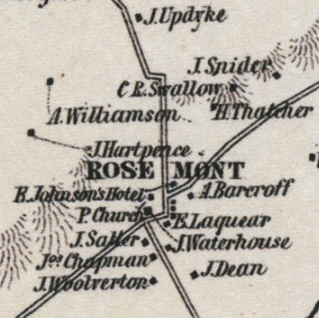
The first initial of the hotel owner’s name appears to be either “R.” or “B.” but was no doubt an “E,” because at the time, the hotel proprietor was Elias S. Johnson (1810-1892), son of William Johnson and Urania Sergeant who ran the tavern/hotel. The reason for thinking so is that in 1835, he married Sarah Wolverton, daughter of (none-other-than) James P. & Mary Ann Wolverton. Also, in the 1850 census, Johnson, age 39, was identified as a tavernkeeper of Delaware Township, living with wife Sarah, age 30, and their children, Thomas 11, James 9, Uriah 5, William 3, and John 4 months (who may have died an infant). Also living in the household (I should say ‘hotel’) were Coryell Conard 27 wheelright, Francis Cullins 19 laborer, Hannah Agin 26, Caroline Agin 15, and William F. Stone [?] 24, Doctor.
Prior to 1850, Elias S. Johnson was earning a living by selling lumber. He acted as an agent for John Kenderdine in 1840 when he advertised “New Lumber Yard. At his residence in Delaware twp. opposite the Lumberton Lumber Yard.”12 In 1844, he advertised the sale of “Susquehanna Pine Shingles” for sale “at Rittenhouse’s Tavern in Delaware Township and at Johnson’ Ferry near Bools Island.” Johnson’s Ferry was located a little south of Saxtonville, and was run by his grandfather, Martin Johnson.
The next item in the Gazette tells us that Elias S. Johnson had taken over the tavern by 1849. On March 28, 1849, one Henry Gordon announced the public sale of 14 horses to be held “at the house of Elias S. Johnson, in Rose Mont.” I suspect that Johnson took over the tavern house very soon after Stedman Cowdrick left.
Rosemont Got its name in the 1840s
Probably the last evidence of the old name of Rittenhouse Tavern was the notice of 1844, cited above. But that was soon to change. On June 4, 1845, Fanny Barcroft, daughter of Ambrose Barcroft and Anna Woolverton, was married to Peter Ten Broeck Runk, ancestor of the Woolverton genealogist, Emma Ten Broeck Runk. The guests at the wedding jointly concluded that the place ought to have a new name, and easily settled on Rosemont. I imagine that roses played an important part in the wedding decorations.
This story comes from Hubert G. Schmidt, author of Rural Hunterdon, who came across the story when reading a history of the Barcroft family.13 It is fitting that it took place at the Barcroft home, which was located south of Rosemont, on property that had originally been the home of William and Catharine Rittenhouse. I should also mention that Anna Woolverton Barcroft, Fanny’s mother, was the sister of James P. Woolverton.
It appears, however, that at first there was not universal agreement on how the name should be spelled. For instance, on January 14, 1846, James Woolverton placed this notice in the Hunterdon Gazette:
“Store Stand & Dwelling to Rent. A Store Stand situate at Rosemount, (formerly called Rittenhouse’s Tavern) in Delaware township, is offered for rent. Possession can be had immediately. For terns and particulars apply to the subscriber, living near the place. James Woolverton.”
Apparently Cowdrick & Dilworth accepted Woolverton’s offer shortly after the notice was published. On May 13, 1846 they advertised mackerel, kegs of white lead, and a large assortment of crockery available at their store in “Rose-mont.” And in August of that year, “Dr. Barber’s Embrocation,” a medicine designed for horses, available at several locations, including Cowdrick and Dilworth in “Montrose.”
The village of Rosemont had several inhabitants by this time, and James Wolverton did his part to increase the village population. On June 10, 1851, James and Mary Wolverton sold a small lot on the road from Stockton to Baptisttown (Route 519) to Israel C. Conner, which ran along “a 40-ft Street to be thrown open for public use.” On January 11, 1854, Wolverton sold a lot in the village of Rose Mount to Samuel Hartpence of Kingwood, bordering the previous lot sold to Israel Co. Conner. Hartpence became the village undertaker, a position he held from 1856 to 1900.14
Elias S. Johnson lasted longer than Stedman & Cowdrick did, but by 1856, he was ready to retire. That year he purchased a property from Joseph Leigh, and took up farming. This was the farm that was (much later) owned by Donald and Beverly Jones. From 1856-1859, Johnson participated in local government, serving as a Commissioner of Appeals and as an Overseer of the Poor for Delaware Township. Elias S. Johnson died on March 4, 1892, age 81, and wife Sarah Wolverton Johnson on April 15, 1896, age 76.15
Once Johnson moved away, the hotel reverted back to James Wolverton, as indicated by the Philadelphia Map of 1860, which showed the property as “J. Woolverton Hotel.” Wolverton had found another tenant by then, a man named John Slack. The 1860 census identified John Slack as a hotelkeeper in Delaware Township. Mr. Bush wrote:
John Slack kept the tavern for several years while Woolverton owned it. Slack like gatherings and lively times. Old people still tell of a dance party held in the wood that then extended across the upper end of the farm to the road. Somebody emphasized his strong opposition by gathering a supply of stale eggs, stealing down among the trees and bombarding the dancers with unerring aim. The perfumery was well distributed, the fumes were stifling, and the dancers rushed for their homes without seeking vengeance on the aggressor.
It seems John Slack was an easy-going sort of fellow. However, it is hard to pin him down. He was not a tavernkeeper in 1850, for that year the census identified him as a farmer: John P. Slack, age 45, living with wife Mary A. 45, Burrows Slack 19, William P. Slack 16, Elizabeth Slack 14 and Margaret Slack age 10. In 1860, when he was a hotel keeper, the census of that year stated that the post office was at Raven Rock, not at Rosemont, which reinforces Mr. Bush’s statement that Rosemont did not have a post office. But in fact, it did get one much later, in 1884, with the first postmaster being Ezekiel Bonham. (See Delaware Township Post Offices.)
By 1868, Slack was ready to give up hotelkeeping. On May 28, 1868, he purchased a farm of 93.93 acres on Sanford Road (Block 19 lot 19), formerly owned by Henry Nightingale, bordering Asher Reading and Mathias Williamson.16 But tragically, he died only a few months later, on December 12, 1868, age 63. His widow remained on the farm, which was not sold until 1872.
With the departure of John Slack, James Wolverton seems to have decided it was time to give up the tavern property. On April 16, 1868 (a month before John Slack bought his farm), James Wolverton sold the lot to George Hoppock for a whopping $6300 (compared to the $3200 Wolverton paid for it in 1843).17
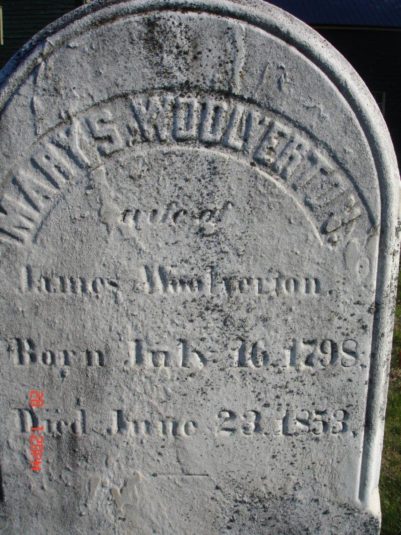
James Wolverton died on March 8, 1871 at the age of 79. His wife Mary Ann had preceded him, dying on January 23, 1853. The couple was buried in the Rosemont Cemetery. There was no obituary for James Wolverton in the Hunterdon Co. Democrat, or for his wife Mary Ann Wolverton.
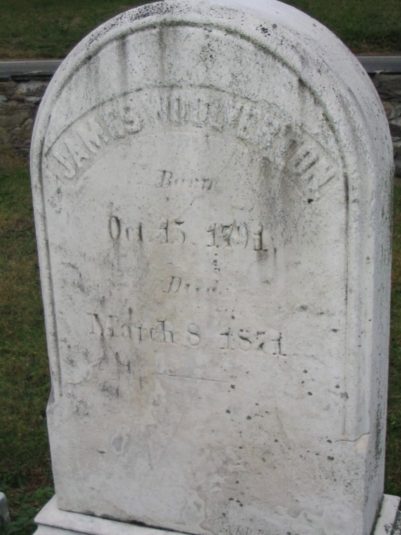
Postscript: The Will of James Wolverton
James P. Woolverton of Amwell wrote his will on April 22, 1870. It is odd he would be identified as “of Amwell” since the township had been divided back in 1838, and in deeds he was always “of Delaware Twp.” He first ordered that his farm of 133.89 acres “where I now live” go to son Charles, and the rest of his real estate to be sold and the income divided equally among the other children. Woolverton’s executors were his sons John, Joseph W. And Samuel Wolverton. On March 30, 1872, they sold five properties as follows: to Charles S. Wolverton, 53.28 acres that had been sold to James’ father John by Darius Everitt; also to Charles S. Wolverton, 35.65 acres that had been sold to John Wolverton by John & Joseph Sergeant; to George Hoppock the 98.03 Kyple farm; to his daughter Mary J. Jones, wife of Charles P. Jones, a lot of 2.06 acres in Rosemont that became the location of the Rosemont Store; and to daughter Sarah S. Johnson, wife of Elias, that farm of Donald & Beverly Jones, that Elias Johnson had lost due to bankruptcy.
George Hoppock & Jane Elizabeth Wolverton, 1868
There were two George Hoppock’s living in Amwell Township in the 19th century, and on occasion both used the middle initial H. But thankfully, they can be easily separated because one of them spent his life in Sand Brook and the other in Rosemont.
The George Hoppock of Sand Brook was the son of Henry J. Hoppock (1797-1879) and Lydia Wolverton (1804-bef. 1879), daughter of Charles Wolverton, a cousin of James Wolverton of Rosemont. This George Hoppock of Sand Brook was the brother of the local historian, Jonathan M. Hoppock.
The George Hoppock we are concerned with here was the second child of William L. Hoppock, Sr., the very successful miller of Prallsville, and Jane Heed, daughter of Abraham and Jane Heed. George was born on November 20, 1820 in Solebury, Bucks County, where his parents were living before William Hoppock began acquiring his many properties in and around Prallsville.18 The Hoppock Family Tree has just been published down to five generations, which is just far enough to include the parents of both Georges.
George Hoppock was married on January 15, 1845 to Jane Elizabeth Wolverton, daughter of James P. and Mary Ann Sergeant Wolverton by Rev. Dr. Studdiford, pastor of the Lambertville Presbyterian Church.19 The couple had three children. The first was David Wilson Hoppock, born June 2, 1846, then Mary Jane Hoppock, born November 4, 1850, and finally Emma W. [probably Wolverton] Hoppock, born August 6, 1855. David moved to Solebury, where he married Lucretia D. Livezey about 1878. Mary Jane remained unmarried and lived with her parents. Emma W. Hoppock married Edward Shepherd of Sergeantsville.
Hoppock Acquires the Tavern Lot
Just like William Rittenhouse in 1843, James P. Woolverton conveyed the tavern lot to his son-in-law. This happened on April 16, 1868, when James Woolverton of Delaware Twp. conveyed the tavern lot of 59.98 acres to George Hoppock for a handsome $6,300.20 The lot bordered “the public road from Lambertville to Pittstown at the Junction of the Road from Sergeantsville (at Rosemont).” Bordering owners were Andrew Sherman (on the north), Joseph Reading (on the east) and Nathan Cain, across the road on the south.
Wolverton seemed to be expecting a lot from his son-in-law. The difference between the $6300 he charged Hoppock versus the $3200 he paid in 1843 seems much greater than would be caused by ordinary inflation—a $3100 profit!
The census records seem to suggest that George Hoppock did not immediately take up residence at the tavern lot. In 1870, two years after his purchase, he was still living in his parents’ household in Prallsville. It is possible that Wolverton or Hoppock had found a tenant to carry on after John Slack left.
In 1870 George Hoppock was listed as a 49-year-old farmer, with real estate worth $6300 (that would be the tavern lot) and personal property worth $4,000. That surprised me a little, because George’s father Wm. L. Hoppock also had personal property worth that amount, but William had had many years to accumulate wealth, and in fact was not far from the date of his death—in 1874 at the age of 81.
The 1870 census also showed that Jane E. Hoppock was 48 years old, their son Wilson Hoppock was a 24-year-old farmer, daughters Mary G. [sic] and Emma W. Hoppock were 20 and 16.
On March 30, 1872, the executors of James Woolverton dec’d sold a tract of 98.03 acres to George Hoppock, being at one time part of a 145-acre farm belonging to Jacob Kyple, up on Strimples Mill Road. Hoppock quickly resold the farm to Uriah Emmons,21 for a profit of almost $300.
In April 1873, George Hoppock’s father William wrote his will. He made special provision for George’s younger brothers, leaving each of them the sum of $1,000. But George only got an equal share of the estate with his six siblings. I suspect that the reason was that William had helped George raise the $6300 needed to purchase the Rosemont tavern property and the Kyple farm.
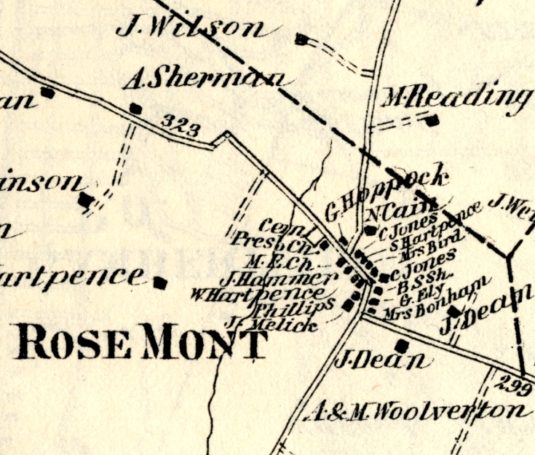
When the Beers Atlas of Hunterdon County was published in 1873, it showed “G. H. Hoppock” as the owner of the tavern lot. But he was probably not running a tavern there. Mr. Bush wrote that it was George Hoppock who discontinued the tavern, and used the house strictly as a residence.
In the census of 1880, George Hoppock was listed as age 58, a retired farmer, and resident of Stockton Village rather than of Delaware Township. His wife Jane was also 58, and daughters Mary and Emma were 29 and 24.
Rosemont in the 1880s
When Snell’s History of Hunterdon County was published, the village of Rosemont was about as large as it was going to get. Snell gave a summary of the primary commercial endeavors in 1880:
There are at present a store kept by Samuel Hartpence ; a blacksmith-shop by W. A. Shepherd ; a carriage- and sleigh-factory by R. C. Phillips ; a harness-shop by H. A. Chapin ; an undertaker, Samuel Hartpence ; a shoemaker, Mahlon Williamson ; two churches, Methodist Episcopal and Presbyterian ; one physician, G. N. Best. Population of the village in 1880, 50.22
By 1887, the family of George and Jane Hoppock consisted of only themselves and their daughter Mary, then 37 years old. So there was no particular reason to enlarge the old house. But it must have been in bad shape and in need of upgrading, because this item appeared in the Hunterdon County Democrat in 1887.
1887 PRESIDENTIAL — The house owned by Mr. George Hoppock at Rosemont is now undergoing an overhauling. This is an old relic, built in 1754. . . . It was long known as Rittenhouse’s tavern. It is reported that Gen. Washington took dinner in the house during the period of the Revolutionary War.23
George Hoppock, wife Jane and daughter Mary most likely moved back to the old tavern house after improvements were made. In 1900, Hoppock was listed as 79 years old and unemployed; wife Jane was 77 and daughter Mary was 49. Hoppock’s wife Jane died on December 24, 1902, age 80. George Hoppock died on February 5, 1905, age 84. Both were buried in the Rosemont Cemetery. Daughter Mary lived on until her death on Dec. 23, 1921, age 70.24 She was buried along with her parents.
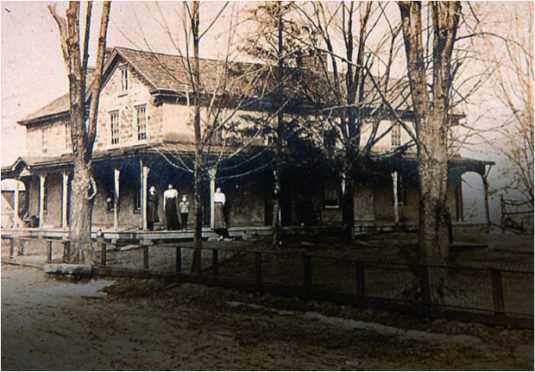
The above photograph is not dated, so I am just guessing that it depicts members of Hoppock’s family standing on the porch, which may well have been added during the improvements of 1887.
It took Hoppock’s heirs five years to finally sell the old tavern property, which they did on March 31, 1910 to the long-time storekeeper of Rosemont, Lambert B. Mathews, who’s history will be related in the next post.
Footnotes:
- H. C. Deed Book 79 p. 401. ↩
- I will be writing more extensively about the Wolverton family and its history in the Rosemont neighborhood in a future post. However, The Wolverton Family Tree has been published. As for the “P” in James’ name, I have not seen any record with the name spelled out, and know of no relative with a surname beginning with P. ↩
- Emma Ten Broeck Runk, The Woolvertons; Early Legal Records of the Family in New Jersey, And the Descendants of Charles Woolverton (2) to the 7th Generation, Philadelphia: Press of Harris & Partridge, Inc., 1932. ↩
- The farm from Richard Reading is described in Egbert T. Bush’s article “The Woolverton Farm Near Stockton in Family Since 1799,” which I will publish in the future. ↩
- H. C. Deeds, Book 60 pp. 265, 267. ↩
- In 1838 Apr 1, John Woolverton’s daughters, Sarah, Margaret and Nancy made a deed of partition and division, settling what properties each would have title to, as described in their father’s will. The deed was not recorded until 1865 (H. C. Deed Book 131 p. 729), but it had nothing to do with James P. Woolverton. ↩
- H. C. Deed Book 79 p.401. ↩
- H. C. Deed Book 56 p. 112. ↩
- See The Last Chapter of the Saxtonville Mill and other articles on Goodspeed Histories, for the Dilworth connection with Saxtonville. ↩
- Hunterdon Gazette, April 22, 1846. ↩
- H.C. Deed Book 94 pp. 612, 405. ↩
- Hunterdon Gazette, August 26, 1840. ↩
- The story was republished by Clint Wilson in his column for the Hunterdon Democrat. Unfortunately, the clippings I obtained of Wilson’s articles are all missing their dates. ↩
- H. C. Deeds, Book 107 p. 568; Book 110-116. ↩
- Surprisingly, their graves are not listed on Find-a-Grave. ↩
- H. C. Deed Book 140 p. 341. ↩
- H. C. Deed Book 140 p. 351. ↩
- This is where it is tempting to go off on another subject and write at length about William L. Hoppock and his development of the mill at Prallsville. I hope to do just that in the future. In the meantime, check out Egbert T. Bush’s article “Milling Industry at Prallsville.” ↩
- H.C. Marriages, Book 2 p. 312. ↩
- H.C. Deed Book 140 p. 351 ↩
- H. C. Deeds Book 151 p. 505, and 151 (or 153) p. 506. ↩
- James P. Snell, History of Hunterdon and Somerset Counties, 1881, p. 376. ↩
- Found in the series “Old Ink,” which was published in the Democrat for many years. It did not identify exactly what month and day this item was originally published. ↩
- I do not know where she spent her last years; I could not find her in the census records. ↩
Goodspeed Histories: Two Articles this Week!
August 29, 2018 @ 1:49 pm
[…] 29, 2018 phyllis hartzell This week we have two articles: The Rittenhouse Tavern, continued https://goodspeedhistories.com/rittenhouse-tavern-continued/ & The Hoppock Family Tree […]